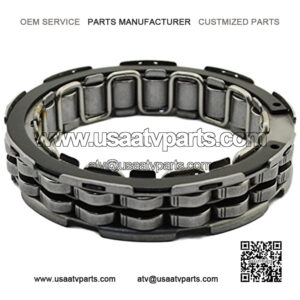There’s no one-size-fits-all solution for side-by-side clutches, and the right clutch kit or upgraded clutch parts for you will depend heavily on both your personal setup as well as the things you do with your machine. No matter what, there are always trade offs you must consider with UTV clutches, and regardless of whether you go with an Outlaw clutch kit by High Lifter for your Can-Am Defender, or a Dalton clutch kit for your Can-Am Commander / Maverick, you’ll want to make sure that your clutch system is tuned so that everything is dialed in for your particular build and driving style. Some riders seek aftermarket Can-Am UTV clutch parts and clutch kits to better handle bigger tires without any losses in power, while others go with aftermarket Can-Am UTV clutch modifications like the KWI float mod for better belt life, lower belt temps, and more wheel horsepower. But regardless of whether you’re after improvements in performance or reductions in wear, here are our thoughts on the best clutches and clutch kits for the Can-Am Defender, Can-Am Maverick / Maverick X3, and Can-Am Commander!
Aftermarket Can-Am Defender Clutching
Aside from aftermarket clutch parts to use as replacements for stock clutching components that go bad, most Defender owners get clutch kits to make their machines better equipped to turn bigger tires and wheels. Do you need to do clutch work in order to run bigger tires? Not necessarily. Is it worth it to do clutch work after installing bigger tires? Almost certainly!
Before we get into the various aftermarket clutch kits and clutch mods for the Can-Am Defender, it’s important to note that you have to break in the belt as well as the clutches in a new buggy before they really begin to function properly. As such, don’t be surprised if your unit is super jerky for the first few rides if you purchased it new from a dealership.
As far as clutch upgrades go, EPI makes a good Can-Am Defender clutch kit for riders that want more snap off the line with improved acceleration from 0-45 MPH. EPI’s kit achieves this by using tighter springs and a steeper helix angle. Consequently, you’ll lose a little acceleration between 50 and 65 MPH, but you’ll get better performance in the usable trail and mud hole speed range. If you don’t intend on going any bigger than 30 inches with your tires, this is a solid kit for you.
While the EPI Mudder Kit will give you back lost power as well as save your belt, it’s not the right kit for those who are serious about racing, or those who run tires larger than 32”. For all the big-tire guys and gals out there, the Can-Am Defender clutch kits by QSC are great. Not only do these kits come with adjustable weights, but they’ll also take all the junk and clunk out of your clutch. Many riders have found that their machines are less jumpy when accelerating with a QSC clutch kit installed, and the kit also allows for incredibly smooth starts when the vehicle’s bed is fully loaded or a pull-behind trailer is attached.
For riders who are flush and willing to spend on top performance without compromises, billet clutches, Airdam clutches, or the Outlaw Super Duty Extreme Clutch Kit by High Lifter are all quality options that won’t disappoint! Although you’ll never get those butter-smooth starts like you can in side-by-sides with wet clutches — due to the initial engagement of the primary — you can fine-tune your throttle feel and upgrade clutch components to eliminate much of the lurching and bumpiness that you feel during takeoff.
Because the motor and clutch setup in the Defender is “sitting on go” so to speak, you shouldn’t pussyfoot it when coming off idle. You want it to engage at a higher RPM, so by giving it more throttle off the line, things won’t feel as jerky. Then, once you’re moving forward, you can back off on the accelerator. This takes some getting used to, even when coming from a similar UTV like the Polaris Ranger. At the end of the day, though, it’s just part of the deal. Although you might be able to get away with a slightly lower engagement, if you take away too much, the flyweight system will not backshift the belt correctly when the system comes under load
Aftermarket Can-Am Commander Clutching
If you feel like the clutch engagement in your rig is far from smooth, an EPI Mudder Kit, a primary clutch rebuild kit, a one way bearing kit, and a new belt will help your clutch system engage faster as well as give you longer engine braking. A good belt alone might be sufficient to take the clunk out, but you might also want a low-engagement spring for better clutch performance as well.
Like EPI, QSC also makes good clutch kits for both the Commander and the Defender. The billet Rage P3 primary from STM is another great option for vehicles on 32”+ tires, but you can get better results if you also upgrade the spring in your stock secondary. Billet clutches like those by STM are almost compulsory for structural integrity, but the stock Can-Am Commander clutch is able to handle tire sizes below 30”.
Using a UATV Tech low engagement primary spring should eliminate any clutch clunking you’re experiencing, and many riders swear by the Can-Am Commander CVTech primary clutch by High Tech Powersports. With the Commander Max, however, you’ll want to go with STM, as there is way too much weight / load for the CVTech primary to handle. If, on the other hand, you’re looking to fix rather than upgrade your clutching system, other options might be better suited to fit your needs.
You might be able to feel, hear, or smell something off with your clutch, but you won’t be able to diagnose anything for sure until you take it apart. Once the clutch is opened up, the problem should become easy to spot. Many times, misalignment among the components in the secondary clutch can cause problems. So you’ll want to make sure the clutch is positioned correctly so that it properly mates with the helix. The helix itself should fall into the 3 slots on the backside, and you can use a Can-Am Commander clutch tool to hold the clutch in place while you properly torque the bolt in – making sure to dab some blue Loc Tite on the bolt before reinstalling it.
The factory bolt that holds Can-Am Commander clutches together can also stretch, which will cause a number of issues — one of which being damage to the helix. If this is the case, you’ll want to get an HD Reusable Primary and Secondary Bolt Kit. Clutch maintenance / cleaning kits are also good for everyday upkeep, and if you’re consistently smoking belts, a Maverick 364 belt is a strong alternative to the factory Commander belt.
Aftermarket Can-Am Maverick / Maverick X3 Clutching
Some riders aren’t big on clutch kits for the Can-Am Maverick, and instead go with entirely different primary clutches like the ones by STM. The one-piece STM billet Can-Am Maverick clutch is tunable, and to date, the Rage 3P will put down more torque than any other clutch on the market. Furthermore, if your rig has been eating belts left and right, a full STM clutch with the requisite shim / weight adjustments will help to prevent your belts from shredding.
QSC primary clutch kits are good for the OG Maverick, and many riders also put OG turbo Maverick clutches in their non-turbo machines. But what about the Maverick X3? Aside from Can-Am Maverick X3 clutch kits by companies like Trinity Racing, Dalton, and EPI Performance, you can also send your clutches into firms like KWI to have them add things like float mods, shave the sheaves, or install bigger rollers. This will not only help your belts last longer, but it’ll also make engagements much smoother.
To run large 35” tires without losing a noticeable amount of speed, you could try putting the secondary into the next hole up to increase the engagement RPMs. But if your rig is still feeling sluggish, the additional heal slots on IBEXX Stage 3 clutches are sure to give your rig some extra punch! Alternatively, if you’ve got a lower-horsepower 120 HP Maverick X3, some Turbo R weights, an RR primary spring, and stronger secondary rollers should yield good results!
About can am aftermarket
“can am aftermarket parts”
“can am aftermarket exhaust”
“can am aftermarket wheels”
“can am aftermarket clutch”
“best can am aftermarket parts”


